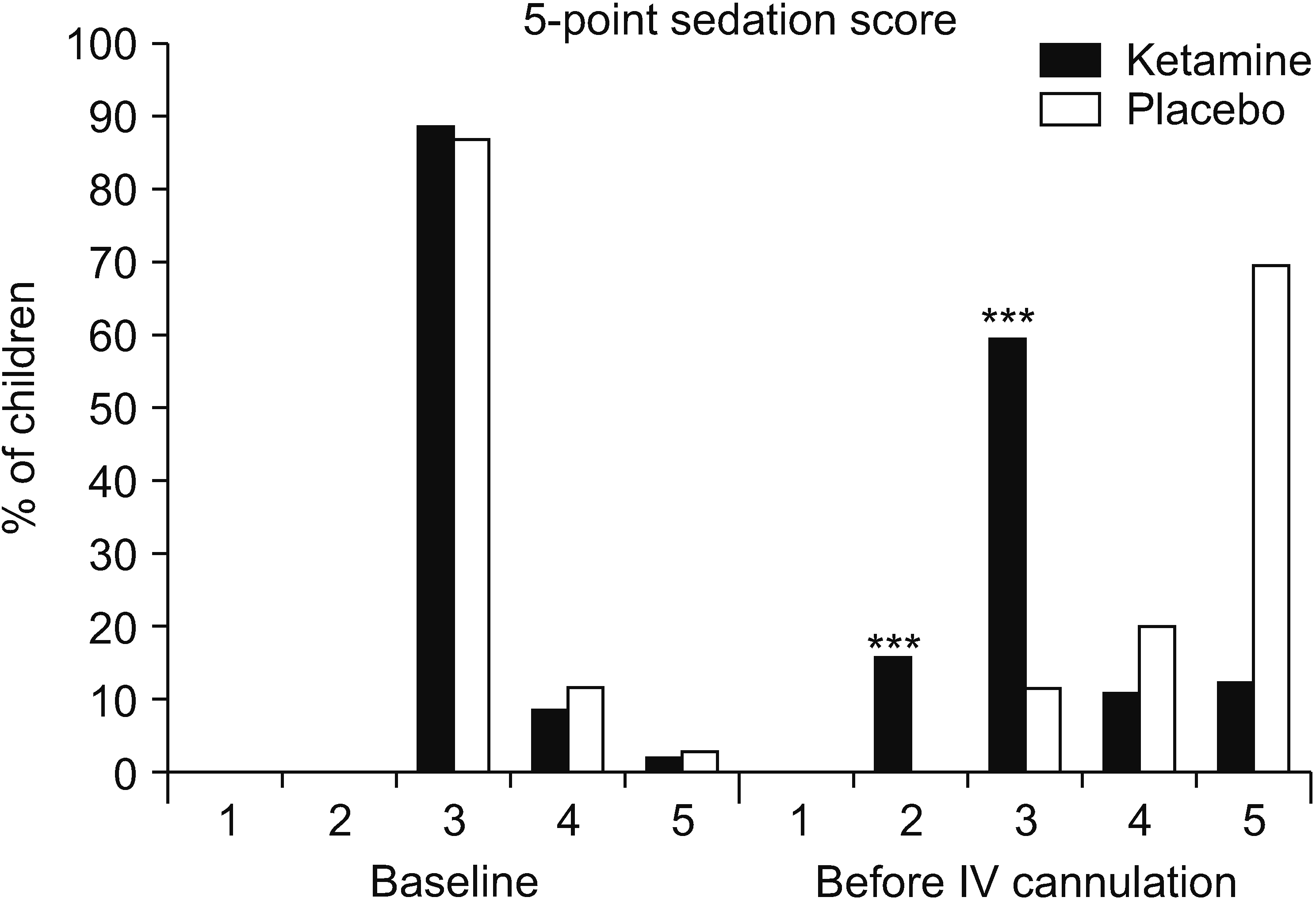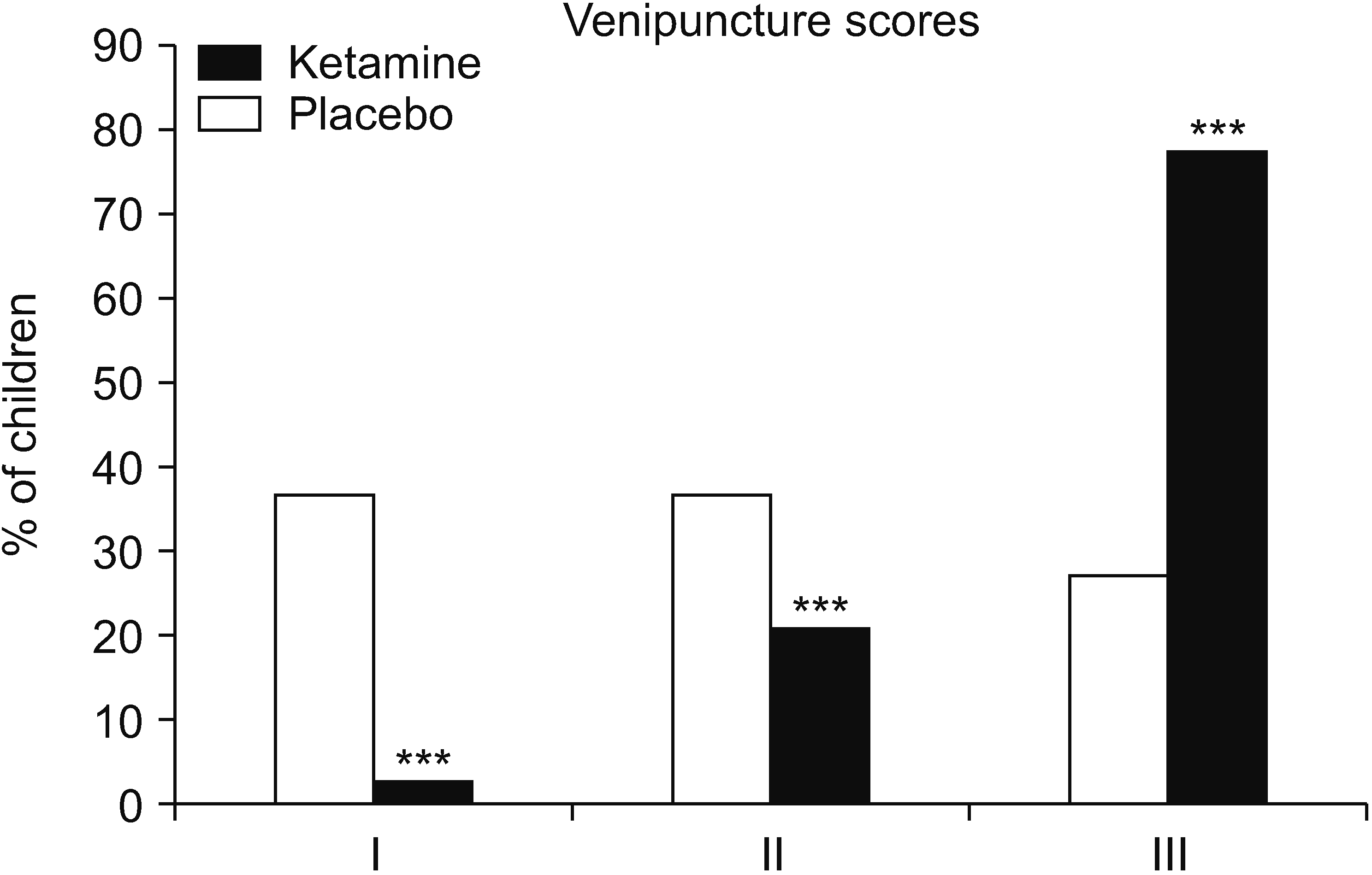3. Fradet C, McGrath PJ, Kay J, Adams S, Luke B. 1990; A prospective survey of reactions to blood tests by children and adolescents. Pain. 40:53–60. DOI:
10.1016/0304-3959(90)91050-S. PMID:
2339016.

4. Green SM, Krauss B. 2004; Clinical practice guideline for emergency department ketamine dissociative sedation in children. Ann Emerg Med. 44:460–71. DOI:
10.1016/j.annemergmed.2004.06.006. PMID:
15520705.

5. Green SM, Rothrock SG, Harris T, Hopkins GA, Garrett W, Sherwin T. 1998; Intravenous ketamine for pediatric sedation in the emergency department: safety profile with 156 cases. Acad Emerg Med. 5:971–6. DOI:
10.1111/j.1553-2712.1998.tb02773.x. PMID:
9862587.

6. Green SM, Rothrock SG, Lynch EL, Ho M, Harris T, Hestdalen R, et al. 1998; Intramuscular ketamine for pediatric sedation in the emergency department: safety profile in 1,022 cases. Ann Emerg Med. 31:688–97. DOI:
10.1016/S0196-0644(98)70226-4. PMID:
9624307.

7. Sherwin TS, Green SM, Khan A, Chapman DS, Dannenberg B. 2000; Does adjunctive midazolam reduce recovery agitation after ketamine sedation for pediatric procedures? A randomized, double-blind, placebo-controlled trial. Ann Emerg Med. 35:229–38. DOI:
10.1016/S0196-0644(00)70073-4. PMID:
10692189.

8. Sotoodehnia M, Farmahini-Farahani M, Safaie A, Rasooli F, Baratloo A. 2019; Low-dose intravenous ketamine versus intravenous ketorolac in pain control in patients with acute renal colic in an emergency setting: a double-blind randomized clinical trial. Korean J Pain. 32:97–104. DOI:
10.3344/kjp.2019.32.2.97. PMID:
31091508. PMCID:
PMC6549592.

11. Oyedepo OO, Nasir AA, Abdur-Rahman LO, Kolawole IK, Bolaji BO, Ige OA. 2016; Efficacy and safety of oral ketamine premedication in children undergoing day case surgery. J West Afr Coll Surg. 6:1–15. PMID:
28344934. PMCID:
PMC5342622.
14. Oriby ME. 2019; Comparison of intranasal dexmedetomidine and oral ketamine versus intranasal midazolam premedication for children undergoing dental rehabilitation. Anesth Pain Med. 9:e8522. DOI:
10.5812/aapm.85227. PMID:
30881910. PMCID:
PMC6412317.

15. Soleimanpour H, Mahmoodpoor A, Eftekhari Milani F, Shahsavari Nia K, Mehdizadeh Esfanjani R, Safari S. 2014; Effectiveness of oral ketamine, midazolam, and atropine cocktail versus oral diphenhydramine for pediatric sedation in the emergency department. Iran Red Crescent Med J. 16:e21366. DOI:
10.5812/ircmj.21366. PMID:
25593736. PMCID:
PMC4270670.

16. Kamel AAF, Amin OAI. 2020; Analgo-sedative effects of oral or nebulized ketamine in preschoolers undergoing elective surgery: a comparative, randomized, double-blind study. Pain Physician. 23:E195–202. DOI:
10.36076/ppj.2020/23/E195. PMID:
32214298.
17. Majidinejad S, Taherian K, Esmailian M, Khazaei M, Samaie V. 2015; Oral midazolam-ketamine versus midazolam alone for procedural sedation of children undergoing computed tomography; a randomized clinical trial. Emerg (Tehran). 3:64–9. PMID:
26495384. PMCID:
PMC4614601.
18. Şekerci C, Dönmez A, AteŞ Y, Ökten F. 1996; Oral ketamine premedication in children (placebo controlled double-blind study). Eur J Anaesthesiol. 13:606–11. DOI:
10.1097/00003643-199611000-00011. PMID:
8958493.

20. Kimiaei Asadi H, Nikooseresht M, Noori L, Behnoud F. 2016; The effect of administration of ketamine and paracetamol versus paracetamol singly on postoperative pain, nausea and vomiting after pediatric adenotonsillectomy. Anesth Pain Med. 6:e31210. DOI:
10.5812/aapm.31210. PMID:
27110529. PMCID:
PMC4834744.

21. Barkan S, Breitbart R, Brenner-Zada G, Feldon M, Assa A, Toledano M, et al. 2014; A double-blind, randomised, placebo-controlled trial of oral midazolam plus oral ketamine for sedation of children during laceration repair. Emerg Med J. 31:649–53. DOI:
10.1136/emermed-2012-202189. PMID:
23686730.

22. Funk W, Jakob W, Riedl T, Taeger K. 2000; Oral preanaesthetic medication for children: double-blind randomized study of a combination of midazolam and ketamine vs midazolam or ketamine alone. Br J Anaesth. 84:335–40. DOI:
10.1093/oxfordjournals.bja.a013435. PMID:
10793592.

23. Turhanoğlu S, Kararmaz A, Özyilmaz MA, Kaya S, Tok D. 2003; Effects of different doses of oral ketamine for premedication of children. Eur J Anaesthesiol. 20:56–60. DOI:
10.1097/00003643-200301000-00010. PMID:
12553389.

24. Horiuchi T, Kawaguchi M, Kurehara K, Kawaraguchi Y, Sasaoka N, Furuya H. 2005; Evaluation of relatively low dose of oral transmucosal ketamine premedication in children: a comparison with oral midazolam. Paediatr Anaesth. 15:643–7. DOI:
10.1111/j.1460-9592.2004.01513.x. PMID:
16029398.

25. Javid MJ, Hajijafari M, Hajipour A, Makarem J, Khazaeipour Z. 2012; Evaluation of a low dose ketamine in post tonsillectomy pain relief: a randomized trial comparing intravenous and subcutaneous ketamine in pediatrics. Anesth Pain Med. 2:85–9. DOI:
10.5812/aapm.4399. PMID:
24223344. PMCID:
PMC3821120.

26. Hatton RC, Patel J, Low MW, Ganesh O. 2013; Use of oral ketamine by academic hospitals in the US. Ann Pharmacother. 47:591–2. DOI:
10.1345/aph.1S019. PMID:
23512665.

29. Soto E, Stewart DR, Mannes AJ, Ruppert SL, Baker K, Zlott D, et al. 2012; Oral ketamine in the palliative care setting: a review of the literature and case report of a patient with neurofibromatosis type 1 and glomus tumor-associated complex regional pain syndrome. Am J Hosp Palliat Care. 29:308–17. DOI:
10.1177/1049909111416345. PMID:
21803784. PMCID:
PMC4239997.
30. Ozdemir D, Kayserili E, Arslanoglu S, Gulez P, Vergin C. 2004; Ketamine and midazolam for invasive procedures in children with malignancy: a comparison of routes of intravenous, oral, and rectal administration. J Trop Pediatr. 50:224–8. DOI:
10.1093/tropej/50.4.224. PMID:
15357562.

32. Tobias JD, Phipps S, Smith B, Mulhern RK. 1992; Oral ketamine premedication to alleviate the distress of invasive procedures in pediatric oncology patients. Pediatrics. 90:537–41. DOI:
10.1542/peds.90.4.537. PMID:
1408506.

33. Beebe DS, Belani KG, Chang PN, Hesse PS, Schuh JS, Liao JC, et al. 1992; Effectiveness of preoperative sedation with rectal midazolam, ketamine, or their combination in young children. Anesth Analg. 75:880–4. DOI:
10.1213/00000539-199212000-00003. PMID:
1443705.

34. Narendra PL, Naphade RW, Nallamilli S, Mohd S. 2015; A comparison of intranasal ketamine and intranasal midazolam for pediatric premedication. Anesth Essays Res. 9:213–8. DOI:
10.4103/0259-1162.154051. PMID:
26417129. PMCID:
PMC4563959.

35. Motamed F, Aminpour Y, Hashemian H, Soltani AE, Najafi M, Farahmand F. 2012; Midazolam-ketamine combination for moderate sedation in upper GI endoscopy. J Pediatr Gastroenterol Nutr. 54:422–6. DOI:
10.1097/MPG.0b013e3182323c75. PMID:
21857244.

36. Norambuena C, Yañez J, Flores V, Puentes P, Carrasco P, Villena R. 2013; Oral ketamine and midazolam for pediatric burn patients: a prospective, randomized, double-blind study. J Pediatr Surg. 48:629–34. DOI:
10.1016/j.jpedsurg.2012.08.018. PMID:
23480923.

37. Qureshi FA, Mellis PT, McFadden MA. 1995; Efficacy of oral ketamine for providing sedation and analgesia to children requiring laceration repair. Pediatr Emerg Care. 11:93–7. DOI:
10.1097/00006565-199504000-00009. PMID:
7596886.

38. Jain K, Ghai B, Saxena AK, Saini D, Khandelwal N. 2010; Efficacy of two oral premedicants: midazolam or a low-dose combination of midazolam-ketamine for reducing stress during intravenous cannulation in children undergoing CT imaging. Paediatr Anaesth. 20:330–7. DOI:
10.1111/j.1460-9592.2010.03279.x. PMID:
20470336.

39. Green SM, Johnson NE. 1990; Ketamine sedation for pediatric procedures: part 2, review and implications. Ann Emerg Med. 19:1033–46. DOI:
10.1016/S0196-0644(05)82569-7. PMID:
2203290.

41. Visintainer MA, Wolfer JA. 1975; Psychological preparation for surgery pediatric patients: the effects on children's and parents' stress responses and adjustment. Pediatrics. 56:187–202. DOI:
10.1542/peds.56.2.187.

42. Schechter NL, Weisman SJ, Rosenblum M, Bernstein B, Conard PL. 1995; The use of oral transmucosal fentanyl citrate for painful procedures in children. Pediatrics. 95:335–9. DOI:
10.1016/0278-2391(95)90146-9. PMID:
7862469.
43. Saarnivaara L, Lindgren L, Klemola UM. 1988; Comparison of chloral hydrate and midazolam by mouth as premedicants in children undergoing otolaryngological surgery. Br J Anaesth. 61:390–6. DOI:
10.1093/bja/61.4.390. PMID:
3190970.

44. Kil HK, Kim WO, Han SW, Kwon Y, Lee A, Hong JY. 2012; Psychological and behavioral effects of chloral hydrate in day-case pediatric surgery: a randomized, observer-blinded study. J Pediatr Surg. 47:1592–9. DOI:
10.1016/j.jpedsurg.2011.12.025. PMID:
22901923.

45. Hamid M, Khan MA, Khatri A, Akhtar I. 2012; Effectiveness of premedication at the time of separation from parent and mask induction in paediatric patients coming for congenital heart disease surgery. J Coll Physicians Surg Pak. 22:280–4. PMID:
22538030.
46. Sajid B, Mohamed T, Jumaila M. 2019; A comparison of oral dexmedetomidine and oral midazolam as premedicants in children. J Anaesthesiol Clin Pharmacol. 35:36–40. DOI:
10.4103/joacp.JOACP_20_18. PMID:
31057237. PMCID:
PMC6495609.

47. Kim KH. 2014; Safe sedation and hypnosis using dexmedetomidine for minimally invasive spine surgery in a prone position. Korean J Pain. 27:313–20. DOI:
10.3344/kjp.2014.27.4.313. PMID:
25317279. PMCID:
PMC4196495.





 PDF
PDF Citation
Citation Print
Print





 XML Download
XML Download